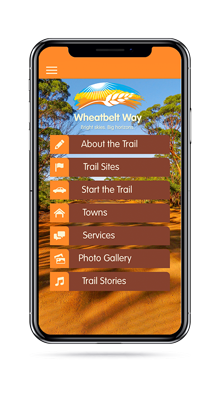I enjoy quiet winding roads shouldered by majestic salmon gums as I make my way to Mangowine Homestead. This hidden gem is located only 281 kilometres north east of Perth, and only 15 kilometres north of the township of Nungarin.
Mangowine’s friendly Caretaker Bob greets me when I arrive and I pay a meagre $4 to visit the property (students, pensioners and concession holders pay an even more meagre $2 per head).
I quickly discover that Mangowine is a wonderful immersive experience, as the buildings have been lovingly restored and furnished to how the area’s pioneers lived in the late 19th century. Bob takes me through to the bar of the Wayside Inn and I imagine the many weary travellers who gladly refreshed themselves over it in the late 1800s.


The room adjoining the bar is furnished as a large ladies lounge with a fireplace and a table set for tea. The Wayside Inn building also includes three small bedrooms which were used to provide lodging for travellers. One of these is fitted out as a ladies bedroom (complete with an extremely scary corset!) and another is furnished as a school room.



I read the local history book and find out that Mangowine was built in 1876 by pioneers Jane and Charles Adams, who took up a number of pastoral leases in the area. They initially built a small cottage to live in, and later another building (which was used as an inn in the late 1800’s) and a larger homestead. Jane was the first white woman to come to the area, and the couple lived an enterprising life. On top of running pastoral leases, they also provided food, lodging and refreshment to passing prospectors and travellers. Charles was also kept busy building wells and working as a local Police Constable. When Charles died at the age of 46, a resilient Jane and her children continued with the business, with Jane also successfully tendering to deliver mail across the district in addition to supplying stores to both locals and visitors to the area.*This historical information is taken from A Piece of String by Maxine Cornish ©2010.
Bob takes me through to the main homestead which was built approximately 10 years after the initial dwelling was constructed. All rooms in the homestead have been fitted out to display the various aspects of life in the early days of Mangowine’s history. The homestead includes a small nursery room, a laundry/bathroom, a main bedroom, kitchen, smoking room and dining room.
The snug main bedroom adjoins the kitchen. Bob affectionately calls this room “the factory,” as Jane and Charles Adams produced 12 children in total.

At the centre of the homestead is a large kitchen and living area, complete with a roomy baker’s oven and fire place.

To the right of this kitchen area is a formal dining room, its table set to feed the Adams family and their guests. This room superbly shows off the beauty of the local gimlet posts visible beneath the rooves of all the dwellings at Mangowine.

Another of this room’s highlights is an 1800’s gentleman’s moustache tea cup featuring an inbuilt moustache guard. This allowed gentlemen to keep their moustache clean and dry while they were taking their tea.

At the back of the homestead is the smoking room. Bob explains that this was a particularly important room in the pre-refrigeration days as it allowed meat to be smoked and cured to extend its life.

As we walk I discover that this National Trust property is much more than a homestead. There is a historic CWA restroom on site, as well as a caravan park, a signed interpretive trail, an outdoor theatre and a wildflower trail to allow visitors to explore the flora and fauna that covers Mangowine’s sprawling 16 acres.


We wander in a southerly direction to see the earliest purpose built CWA restroom constructed in Western Australia. This restroom was built in 1928 at Baandee and much later was relocated to Mangowine. The CWA restroom consists of a fully equipped meeting room and a kitchen at the rear.
We then double back to the tiny cottage that the sizeable Adams family lived in for many years at the front of the homestead. The cottage has been re-modelled as an office, with its small rear kitchen now a store room. Immediately below the cottage is the Adams family cellar, which is shown in the photo to the left below. The tiny cottage is shown as it stands to the left of the Wayside Inn building in the photo to the right.


Bob then takes me across to Mangowine’s fantastic outdoor theatre. This is used each year during the annual Mangowine Concert, and accommodates audiences of 1,000 people.

I ask Bob about Mangowine’s accommodation services for travellers. He reports that Mangowine has 14 powered caravan park sites and an extensive number of unpowered sites on its large grounds. I notice some lovely shady trees on site, and the daily rates are a highlight. I am informed that a powered site is only $12.50 per night, and an unpowered site only $7.00 per night. A barbecue, wood and a number of fire buckets are also available free of charge. As Mangowine is perched on a rise, I observe that good views over surrounding farm land are on offer, and it occurs to me that its rural solitude would be just the ticket for a great night’s sleep. Bob advises that group bookings can also be easily accommodated and visiting clubs can organise in advance with him to use the CWA restroom for meetings, morning teas or meals.


When I finally drive out of Mangowine, Bob having generously answered several million questions and taken the time to entertain me with a number of stories, I feel inspired, happy and lucky to live in a state like Western Australia, where hidden gems like Mangowine can still be found.
By Annemaree Jensen who writes at https://extramilewriting.com.au/



